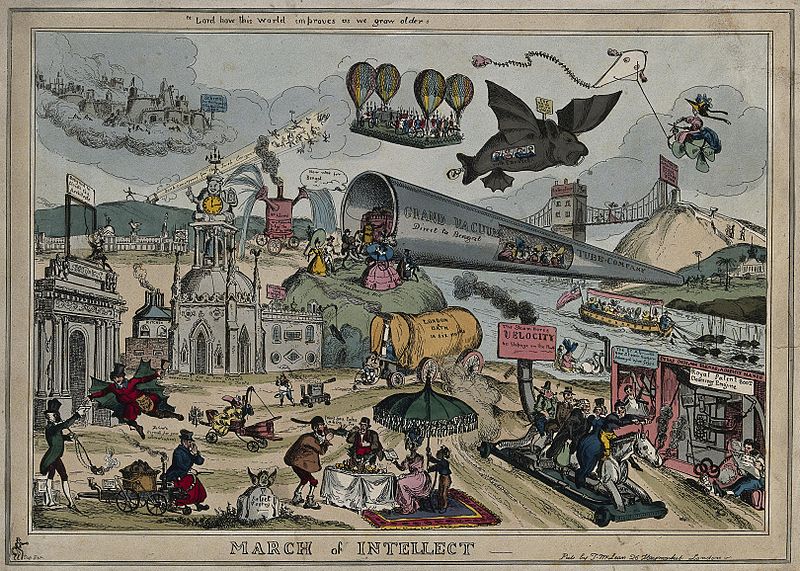People have always needed to get from here to there whether by foot, by horse, by ship, by train, by car, by bus or by plane. Civilization DEPENDS on the mobility of humans and the produce they cultivate and extract from the earth. Without mobility everything would grind to a halt. Human mobility—like drinkable water, waste disposal, roads, grain storage and buildings (for government, religion, and commerce)—is a prerequisite to human civilization.
Human mobility may be aided by businesses which manufacture vehicles, motorized and non-motorized; supply concrete and asphalt for roadways, sidewalks and tarmacs; supply fuel; and build facilities that are part of the mobility infrastructure. But this is all in service to something essential to civilization, something that is the glue of civilization. Airplanes are optional to civilization. They create a certain kind of civilization. But civilization has been around, of course, for a very long time before airplanes arrived.
Governments typically organize transportation systems and then build the necessary infrastructure and purchase the vehicles or license the purchase of vehicles by others. This is how it is done because mobility is NOT optional for civilization.
Mass transit—the kind of transit in deep trouble right now because of the pandemic—is a product of cities’ dense accumulations of people. Though we identify mass transit with the modern industrial city, it has been around for as long as cities themselves. Any locale where there has been a rickshaw, livery horse or carriage for hire has mass transit—by which I mean a system of vehicles that is SHARED by unrelated persons.
You can easily find stories today about the deepening financial distress of mass transit systems in New York City and Washington, D.C. In my experience, the Washington Metro, the tri-state light rail system, isn’t entirely empty as depicted in the linked story. But it is very far from the packed-to-gills, standing-room-only affair it used to be during rush hour. Ridership is reported to be down 80 percent. In the San Francisco Bay Area, the BART light rail system in down 90 percent.
Who still rides on these systems? People who have to because their livelihoods depend on it. This is another grouping of essential workers who tend the grocery stores, staff the hospitals, round out the construction crews and serve at the few restaurants still open. They also tend to other people’s children and clean other people’s houses and care for other people’s gardens and lawns. These activities depend heavily on the reliability and availability of public transit.
What most people don’t know is that public transit systems get only a little more than a third of their operating revenues from fares. So, while the drop in fares has been painful, the expected drop in local and state funding due to plummeting tax revenues and transit-dedicated sales and property taxes will be even more painful. Cities and states do not have the option of running deficits. The U.S. federal government can run deficits, and it is running huge ones already to combat the economic downturn associated with the pandemic. With cities and states faced with having to shrink their spending at a time of rising need, there is a big fight in the Congress over providing more aid to cities and states.
Those who pretend to be concerned with the health of Americans and of the American economy need to understand that the two are heavily dependent on the essentials of civilization which government must generally organize and substantially fund. Transit is one of those essentials. To expect transit to “pay for itself” is fundamentally to misunderstand its purpose. Transmit makes possible much of the private commercial activity of cities, not the other way around.
Transit consultant Jarrett Walker goes so far as to say that “[t]he goal of transit, right now, is neither competing for riders nor providing a social service for those in need. It is helping prevent the collapse of civilization.” We as a society should “measure all the ways that transit makes urban civilization possible” and then fund it accordingly.
On current trends mass transit in America is trapped in a doom loop. Riders are staying away because they can and wish to work at home. And, they are staying away because they fear being in enclosed spaces with strangers who may be infected with COVID-19. The more they stay away, the more transit systems will have to cut service. And, the more they cut service, the smaller the pool of people who will find it viable and convenient to use mass transit—which will lead to further cuts and accusations that mass transit is no longer relevant.
What is certain is that even if the pandemic is brought under control soon, mass transit will be crippled for years to come and may remain in a doom loop even as the rest of society recovers. This is how civilizations fall, one system at a time. At first, the destruction of mass transit systems will seem like a relatively small inconvenience for many—but certainly not for many others, especially those with low incomes and few transportation options. But a failure of our mass transit systems will cascade through our entire society. And, when this happens, we probably won’t even remember that it was one of the first dominoes to fall.
Image: A futuristic vision (1829) by William Heath using the pseudonym Paul Pry. Via Wikimedia Commons https://commons.wikimedia.org/wiki/File:A_futuristic_vision_Wellcome_V0041098.jpg






